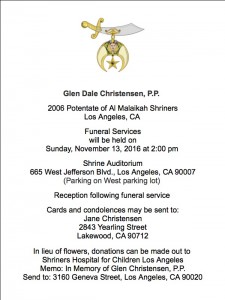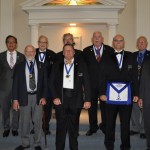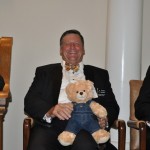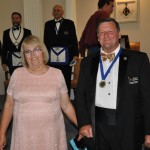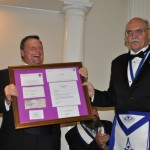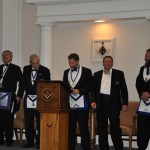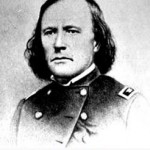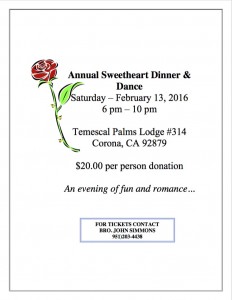Yes, it is true. We have been working with the state DMV to bring Masonic license plates to all who qualify in our great state of California.
Our then AGL, WOR. Frank Lee gave us the approval to start this project in 2010. Our current AGL has given his approval and with the assistance of PGM Wor. Russ Charvonia, myself and Wor. Michael Sekera has been meeting with the proper authorities to proceed with this endeavor. Yes, we have had several “hoops” to get through, but we are preserving to bring this to fruition. After several meetings and presentations to various State Senators offices and other state DMV approved charities, we are getting closer to our goal.
We will keep the Brothers apprised of the status as it goes forward. We kindly ask that ALL brethren support our efforts in order to improve our public presence around the state.
Jim Ridley, Inspector 830th. Masonic District
The latest correspondence from Wor. Michael J. Sekera;
Brothers,
In 2010 within Division 8 we were in different lodges asking ourselves, how we could raise money for the Grand Masters projects as well as other Charities. We thought of us having our own Masonic License Plates. I talked to Worshipful Jim Ridley and he asked me the question which was: “Have I researched it yet and when you do bring it back to me” he then said to me “we needed the Grand Masters approval, but sounds like a great idea”. It’s great to be able to choose to support a very broad range of charities. That is why we think we should choose the California Masonic Foundation.
That is why you should have a California Masonic License Plate. All the proceeds minus the DMV charge will go to the following Charity.
Name of Charity
1) California Masonic Foundation (Proposed)
Our fraternity has a bright history of proudly displaying the square & compasses. In keeping with this tradition, the California Masonic Specialty License Plate will distinguish us among others and promote masonry throughout our travels.
38 States have a Masonic License Plate
For every 5000 plates ordered $200,000.00 will be raised for Masonic Scholarships or other Masonic charities.
Masons along with their wives and Children will be able to order these masonic Plates, so that means we could have a possible 100,000 plates with a possibility of raising about $4,000,000.00.
Sincerely and Fraternally,
Michael J. Sekera,
Master
Palm Springs Lodge #693
Fur trapper, Indian agent, and soldier was Bro. Kit Carson. His exploits west of the Mississippi were as famous as Bro. Daniel Boone's east.
Bro. Kit Caron's father fought in the Revolutionary War, then moved with his family from Kentucky to a tract of land in Missouri owned by Bro. Daniel Boone's sons.
At age 16, Bro. Kit Carson followed the Santa Fe Trail to Taos, New Mexico-capital of the fur trade in the Southwest. He stayed with a friend who had served with his brothers in the War of 1812.
Learning the skills of a fur trapper, Bro. Kit Carson became fluent in speaking: Spanish, Navajo, Apache, Cheyenne, Arapaho, Paiute, Shoshone, and Ute.
Francis Parkman, Jr., wrote in The Oregon Trail:
"The buffalo are strange animals…in order to approach them the utmost skill, experience, and judgment are necessary. Kit Carson, I believe, stands pre-eminent in running buffalo."
In 1835, at the age of 25, he went to the annual mountain man rendezvous in Wyoming, where he met an Arapaho girl named Waa-Nibe or "Singing Grass." After winning a gun fight over her with a French-Canadian trapper, he married her.
Bro. Kit and Singing Grass worked with the Hudson's Bay Company, and renowned frontiersman Jim Bridger, trapping beaver along the Yellowstone, Powder, and Big Horn rivers, throughout Colorado, Wyoming, Idaho, and Montana. Carson considered these years as "the happiest days of my life." Singing Grass died of a fever after giving birth to their second daughter.
Beaver trapping, which drove the exploration of the west, was fueled by demand for beaver top hats popular in eastern America and Europe. Around 1840, when silk from China allowed hats to be made less expensively, demand for beaver ended.
Bro. Carson married a Cheyenne woman, in 1841, but she left him to follow her tribes migration. In 1842, Bro. Carson met the daughter of a prominent Taos family: Josefa Jaramillo. He received religious instruction from Padre Antonio José Martínez, was baptized, married Josefa and together they had eight children.
Bro. Kit Carson led Bro. John C. Frémont on expeditions across the South Pass on the Continental Divide, which "touched off a wave of wagon caravans filled with hopeful emigrants."
Bro. Carson led Bro. Frémont to map the second half of the Oregon Trail, from South Pass to the Columbia River, traveling along the Great Salt Lake into Oregon. They came within sight of Mt. Rainier, Mt. Saint Helens, Mt. Hood, and ventured into crossed into the Mexican territory, where Bro. Carson's wilderness skills averted mass starvation in the Sierra Nevadas. Traveling across the Mojave Desert, they arrived at a watering hole called Las Vegas.
When Congress published Bro. Frémont's reports in 1845, Bro. Carson's reputation as a frontiersman Indian fighter inspired writers to use him as the hero in dime novels.
In 1846, Bro. Carson accompanied Bro. Frémont to California, where he courageously participated in several battles resulting in the State being brought into the Union, even slipping through a siege at night and running 25 miles barefoot through the desert to San Diego for reinforcements.
General Sherman wrote of meeting Bro. Kit Carson in "The Memoirs of General William T. Sherman":
"As the spring and summer of 1848 advanced, the reports came faster and faster from the gold-mines at Sutter's saw-mill…It was our duty to go up and see with our own eyes, that we might report the truth to our Government. As yet we had no regular mail to any part of the United States, but mails had come to us at long intervals, around Cape Horn…
I well remember the first overland mail. It was brought by Kit Carson in saddle-bags from Taos in New Mexico. We heard of his arrival at Los Angeles, and waited patiently for his arrival at headquarters. His fame then was at its height, from the publication of Frémont's books, and I was very anxious to see a man who had achieved such feats of daring among the wild animals of the Rocky Mountains, and still wilder Indians of the Plains.
At last his arrival was reported at the tavern at Monterey, and I hurried to hunt him up. I cannot express my surprise at beholding a small, stoop-shouldered man, with reddish hair, freckled face, soft blue eyes, and nothing to indicate extraordinary courage or daring. He spoke but little, and answered questions in monosyllables…
He spent some days in Monterey, during which time we extracted with difficulty some items of his personal history. He was then by commission a lieutenant in the regiment of Mounted Rifles serving in Mexico under Colonel Sumner, and, as he could not reach his regiment from California, Colonel Mason ordered that for a time he should be assigned to duty with A.J. Smith's company, First Dragoons, at Los Angeles.
He remained at Los Angeles some months, and was then sent back to the United Staten with dispatches, traveling two thousand miles almost alone, in preference to being encumbered by a large party."
After the Civil War, Bro. Kit Carson was a scout for the military, which was carrying out a Federal mandate to subdue the west. He objected to tactics used against the Indians by General James Carleton and Colonel and Bro. Chivington.
Bro. Kit Carson's fame was such that Bro. "Buffalo Bill" Cody named his son after him, as his sister, Helen Cody Wetmore, wrote in "Last of the Great Scouts-The Life Story of Col. William F. Cody 'Buffalo Bill'":
"The first boy of the family was the object of the undivided interest of the outpost for a time, and names by the dozen were suggested. Major North offered 'Kit Carson' as an appropriate name for the son of a great scout and buffalo-hunter, and this was finally settled on."
Helen Cody Wetmore described Bro. "Buffalo Bill":
"He may fitly be named the 'Last of the Great Scouts.' He has had great predecessors. The mantle of Kit Carson has fallen upon his shoulders, and he wears it worthily."
In January of 1868, Bro. Kit Carson was appointed superintendent of Indian Affairs in Colorado. Though breathing with difficulty, he brought Ute Indian Chiefs to Washington, DC., to arrange a treaty.
Traveling through northern cities, they met crowds and posed for pictures with western military notables James Carleton and Bro. John C. Frémont.
While staying with the Indian Chiefs at New York City's Metropolitan Hotel, Bro. Kit Carson almost died. He wrote:
"I felt my head swell and my breath leaving me. Then, I woke…my face and head all wet. I was on the floor and the chief was holding my head on his arm and putting water on me. He was crying. He said, 'I thought you were dead. You called on your Lord Jesus, then shut your eyes and couldn't speak.'
I did not know that I spoke…I do not know that I called on the Lord Jesus, but I might – it's only Him that can help me where I now stand…"
Bro. Kit Carson ended:
"My wife must see me. If I was to write about this, or died out here, it would kill her. I must get home."
Bro. Carson successfully arranged the treaty, as President and Bro. Andrew Johnson wrote:
"I herewith lay before the Senate…a treaty made on the 2d day of March, 1868, by and between Nathaniel G. Taylor, Commissioner of Indian Affairs; Alexander C. Hunt, governor and ex officio superintendent of Indian affairs of Colorado Territory, and Kit Carson, on the part of the United States, and the representatives of the Tabeguache, Muaehe, Capote, Weeminuche, Yampa, Grand River, and Uintah bands of Ute Indians."
Bro. Carson returned to Taos, New Mexio, but unfortunately, his wife Josefa died shortly after from complications giving birth to their eighth child.
A month later, Bro. Kit Carson died of an abdominal aortic aneurysm on May 23, 1868, at the age of 58. He was buried next to his wife.
His last words were: "Adios Compadres" (Spanish for "Goodbye friends").
Masonic Record
The Masonic Record of Bro. Christopher Houston “Kit” Carson shows that at the age of 44 he was initiated an Entered Apprentice on April 22, 1854, passed to the degree of Fellowcraft June 17, 1854, and raised to the sublime degree of Master Mason December 26, 1854 in Montezuma Lodge #101 in Santa Fe Territory of New Mexico. By 1850 there were at least 10 Masons living in the Taos vicinity.
On November 16, 1859 they applied for and received a dispensation from the Grand Lodge of Missouri to form Bent Lodge #204 A. F. & A. M. in Taos, New Mexico. Bro. Carson was the first Junior Warden and the following year moved up to Senior Warden, being a charter member of the same. With the surrender of the charter of Bent Lodge #204 in 1864, Bro. Carson re-affiliated with Montezuma Lodge #101 A. F. & A. M. Santa Fe Territory of New Mexico.
Due to his service in the U. S. Army during the Mexican and the Civil War he was never able to sit as Master of a Lodge.








